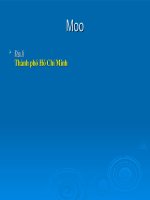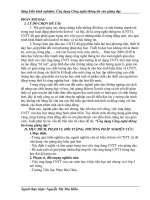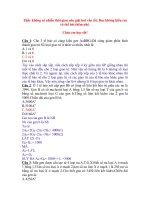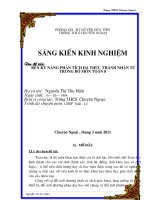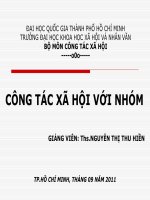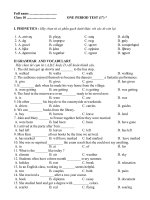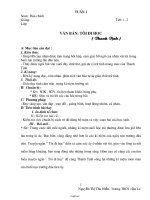Unit 3 language 10 (nguyễn thị thu hiền)
Bạn đang xem bản rút gọn của tài liệu. Xem và tải ngay bản đầy đủ của tài liệu tại đây (157.25 KB, 6 trang )
Date of preparing: ………………………………….
Date of teaching: …………………………………...
UNIT 3: MUSIC
LESSON 2: Language (P.29, 30)
Time: 45 minutes
STAGE 1: DESIRED OBJECTIVES
A. OBJECTIVES
By the end of this lesson, SS will be able to:
1. Recognize stress in two-syllable words;
2. Practice the weak and strong forms of two-syllable words;
3. Identify some lexical items about music through concept check
understanding;
4. Use the lexical items to in the specific context to do exercises;
5. Recognize compound sentences, the difference between to-infinitives and
bare infinitives;
6. Use the structures and their meanings to do exercises in the textbook as well
as communicate in the real life;
B. LANGUAGE FOCUS
Key terms/ Vocabulary:
Key grammartical structure(s): compound sentences, to-infinitives and bare
infinitives
C. INSTRUCTIONAL RESOURCES
- Textbook: English 10 - Unit 3 – Lesson 2 – Page 29, 30
- Computer connected to the Internet
- Projector / TV/ pictures and cards
STAGE 2 – ASSESSMENT EVIDENCES
Performance Tasks
Performance
Assessment tools
products
1. Listen the recording and repeat the
Students’
Observation,
word and then identify stress in twoanswers
questions and
syllable words
answers
2. Read the sentences out loud
Students’
Answer keys,
individually. Then listen and check in
answers
observation
pairs
3. Discusss some lexical items about
Students’
Answer keys,
music through concept check
answers
observation
understanding
4. Use the lexical items to in the
specific context to do task 1 and task 2
in vocabulary in pairs
5. Distinguish past simple and present
simple
6. Use the structures and their
meanings to do task 3 in grammar
Students’
answers
Answer keys,
observation
Students’
answers
Students’
answers
Observation, peer
correction,
Observation, peer
correction
Students’ talks
STAGE 3: LEARNING EXPERIENCES
Lead-in
Activity 1:
PRONUNCIATION
Activity 2: Task 1: Listen and repeat. Pay attention to the stressed syllable
in each word.
-Teacher has Ss read the words individually and check comprehension.
- Teacher plays the recording and ask Ss to listen to the words and repeat and
pay attention to the stressed syllables.
- Ss do as instructed.
- Teacher checks whether Ss can say the words using the correct stress patterns
by calling some Ss to read them aloud.
- Teacher has Ss find out the rule of marking stress on the two-syllable words,
and elicits other examples of nouns, verbs, and adjectives.
Stress on the first syllable
Stress on the second
syllable
singer
programme
common
careful
relax
perform
attract
decide
Activity 3: Task 2: Listen and mark the stressed syllables in the words in
bold.
- Teacher asks Ss to read the sentences individually and pay attention to the
bold words and checks their comprehension.
- Teacher plays the recording for Ss to listen and mark the stressed syllables in
the words in bold.
- Ss do as instructed.
- Ss work in pairs to compare their answers.
- Teacher confirms the correct answers.
- Teacher plays the recording again, pausing after each sentence, for Ss to
repeat.
VOCABULARY: Music
Activity 4: CONCEPT CHECK UNDERSTANDING
Task 1. Match the words with their meanings.
perform
audience
judge
talented
single
- Teacher gives clear instructions, reads the words on the left and makes
sure Ss understand the abbreviation in brackets (v, n, adj)
- Ss work in pairs to discuss and do the matching.
- Ss share the answers with the whole class: one student reads aloud the word and another
reads its definition.
- Teacher confirms the correct answer.
Key: 1. c
2. d
3. e
4. a
5. B
Task 2. Complete the sentences using the word in task 1.
- Teacher has Ss read the sentences carefully to decide which word in 1 can be
used to complete each of the sentences.
- Teacher reminds them to use context clues to decide on the word.
- Ss discuss with a partner.
- Teacher checks answers as a class by having individual Ss call out the word
they have used for each sentence first and explain why they have chosen that
word (the clues in the context), e.g. The first sentence needs an adjective and
the only one on the list is ‘talented’. The second sentence needs a noun, and the
words ‘TV show’ and ‘attract’ suggest that ‘audience’ is the best choice.
- Teacher confirms the correct answers.
- Teacher asks individual Ss to read the complete sentences.
Key: 1. talented
2. audience
3. single
4. judge
5. perform
GRAMMAR
Activity 5: Task 1. Make compound sentences using the correct
conjunctions in brackets.
- Teacher tells Ss to look at the compound sentences in 4 in Getting Started
and asks questions to check whether Ss understand their structure, e.g. What do
they consist of? Can you split them into independent sentences? What are the
clauses joined by?
- Teacher give more explanation and examples for Ss to understand what a
simple sentence is and what a compound sentence is.
+ A simple sentence consists of one independent clause.
Ex: The cat chased the mouse.
+ A compound sentence consists of two or more independent clauses joined
by a coordinating conjunction (e.g. for, and, nor, but, or, and yet, so). (Hint:
The conjunctions spell FANBOYS.)
Ex: The cat chased the mouse, and the mouse ran into the hole.
- Ss work in pairs or individually to choose the appropriate conjunctions to
combine the sentences.
- Individual Ss write their sentences on the board.
- Teacher checks answers as a class.
Key:
1. I am a jazz fan, and my favourite style is from the late 1960s.
2. Jackson wants to go to the music festival on Saturday, but he has a maths
exam on that day.
3. You can book the tickets online, or you can buy them at the stadium ticket
office.
4.The concert didn’t happen, so we stayed at home.
Activity 6: Task 2. Complete the following sentences, using the to-infinitive
or bare infinitive of the verbs in brackets.
- Teacher writes the following sentences on the board and elicits the words toinfinitive and bare infinitive.
E.g.
- When he was 12, his mother started to upload his cover song videos on social
media.
- His beautiful songs have helped bring more love into people’s lives.
- has Ss read the explanation in the Remember! box, checks understanding and
provides some examples of the verbs used in sentences, e.g. I decided to watch
my favourite TV show. My mum let me watch the TV show.
- Teacher asks Ss to read the sentences and identify the main verbs of the
sentences. This will help them decide whether they need to fill in a
to-infinitive or bare infinitive after that main verb.
- Ss do the exercise individually.
- Ss compare answers in pairs.
- Teacher checks answers with the whole class.
Key: 1. to send
2. fall
3. to delay
4. watch
Activity 7: WRAP- UP & ASSIGNMENT
WRAP-UP
* Teacher asks: What have you learnt today?
Suggested answer
- stress in two-syllable words;
- words and phrases related to music;
- conjunctions to make compound sentences;
- to-infinitives and bare infinitives after some verbs.
HOMEWORK
- Exercises in the workbook
- Prepare for lesson 3 Unit 3.
Sầm Sơn, ngày 14 tháng 10 năm
2023
GIÁO VIÊN HƯỚNG DẪN
TẬP
GIÁO SINH KIẾN
Lưu Thị Tuyết
Hiền
Nguyễn Thị Thu
